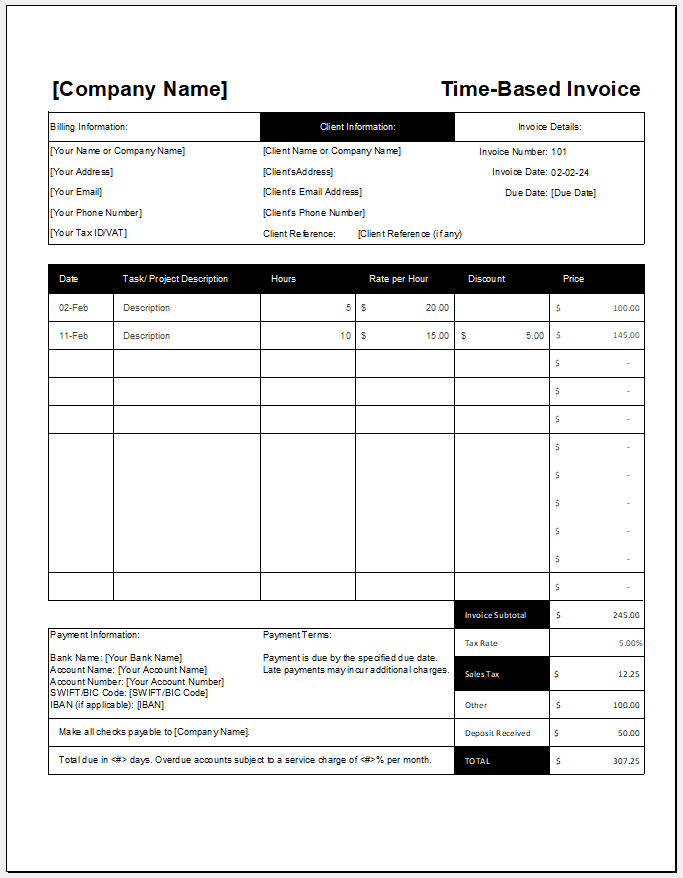Invoices are usually designed and issued to people when they are billed. The concept of using the invoice in the business world is very simple. One party buys products and services and the other party gets paid based on those products and services. Then, according to the change in the situation, the invoice and its use also change. There is a different type of invoice which is known as a time-based invoice.
What is a time-based invoice?
It is a type of bill that is issued to people when the total duration of the project is now known and the price to be paid by the customer depends on the time taken by the project. Sometimes, it is also used because the time duration of each service is different and people are invoiced based on the time duration for which they have used that service.

Invoice Sample Size: 58 KB
When the total amount to be paid by the customer is based on the time they spend rendering a service, it becomes important for them to know for how long they have taken that service and what are the charges for that service.
Mostly, customers are told about the charges of each service per hour and then according to their budget and needs, they decide for how long they can get those services. Customers generally know how much time they have spent and the invoice only confirms it.
What do you expect to see in a time-based invoice?
Just like any other invoice, there are so many details that are very common and expected. However, some such details distinguish this invoice from others. In this section, you are going to see all those details:
Description of services:
The person who receives the bill always wants to know about the services before he chooses to pay. Therefore, the invoice tells him about the services he has taken and some other specific details related to those services.
Most commonly, the buyer can expect to see the name of the service, per-hour service charges, the total number of hours for which the customer has acquired the services, and some other pertinent details.
Details related to costs:
Those who receive the invoice know that they are being charged and they have to incur the cost mentioned on the bill. So, they are mentally prepared for it. However, they always want to go into deep details to see whether they have been charged fairly or not. So, they check the total time mentioned in the invoice and then the time the cost. This way, they can understand the cost details in a better way.
Terms and conditions of the payment:
Almost every invoice these days mentions the terms and conditions of the payment that the seller as well as the buyer should be aware of. This helps them prevent disputes in the future that may arise due to the confusion related to the payment.
Every business has its terms and conditions related to the payment and customers should be aware of it so that they don’t have any trouble in the future. For instance, some businesses have a strict policy of no refund. So, when customers don’t read the policies beforehand and try to get a refund later on, they create disputes that lead nowhere.
When is the time-based invoice used?
In all those situations in which the service provider or the owner of a product provides their services at a specific rate per hour, they can use time-based invoices. Here are some situations in which these invoices are used:
- When someone is working as a freelancer and has a calculated work duration completed in a specific period
- When professional people like business consultants and psychologists provide one-on-one sessions to their clients, they also charge them per hour and they need to issue the time-based invoice.
- When a project has no specific ending and starting point and people working on it are paid based on the number of hours they spend on it every day, the owners of the project use a time-based billing system.
- When lawyers provide legal services to their clients, they are also paid based on the time they spend working.
- Customer Persona Worksheet
- Entertainment Expense Report
- Vendor Expense Report Template
- Market Analysis Worksheet Template
- Customer Sales Tracker Template
- Business Description Worksheet
- Patient Information Cover Sheet Templates
- Goal-oriented to-do List Template
- Individual Expense Report Template
- Travel Expense Report Template
- Corporate Credit Card Expense Report Template
- Bucket List Template
- Mixed Invoice Template
- Progress Invoice Template
- Errands To-do-list Template